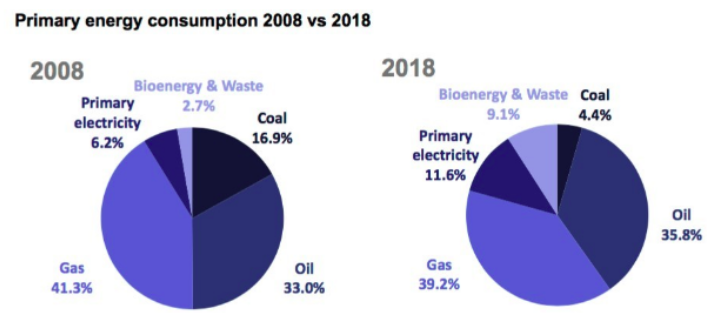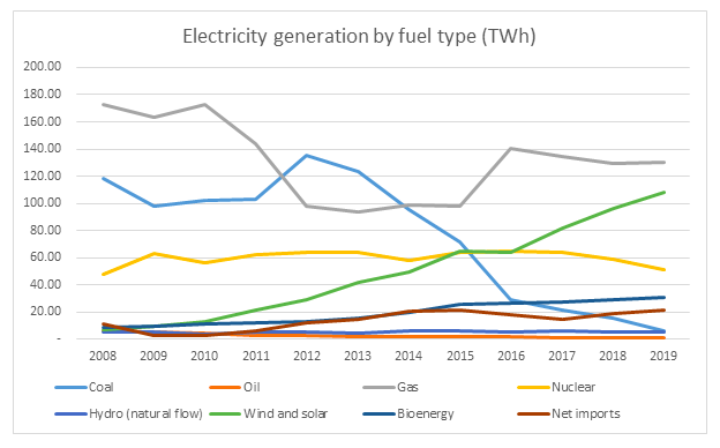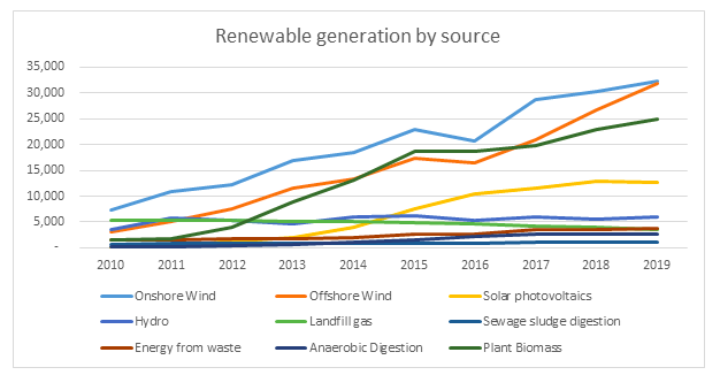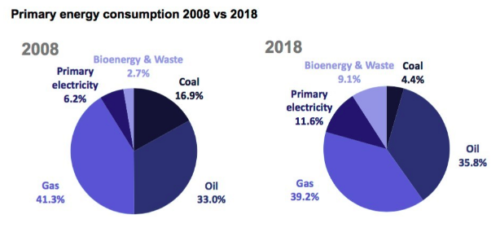UK energy and emissions
Where does the country get its energy from? And what's producing its carbon emissions?

By Dr Simon Cran-McGreehin
@SimonCMcGShare
Last updated:
The UK energy market is dominated by the use of oil and gas, together responsible for around 80% of total energy consumed.
Oil is predominantly used in transport, while gas is mainly used as a source of heat. A smaller proportion of the UK’s gas use is in electricity generation. Almost all coal use is in power stations, but these units are set to be retired by 2024 at the latest. The contribution of coal to the UK’s energy consumption has fallen by more than 10 percentage points in a decade.

Electricity accounts for nearly 20% of UK’s total energy use, a figure which is largely stable over time. In 2019 43% of electricity was from fossil fuels and 37% from renewables. The remainder was provided by nuclear and imports. Coal accounted for just 2% of electricity generation in 2019, down from around 40% in 2012.
Coal use has fallen sharply as uneconomical plants have retired, with output replaced by low-carbon wind and solar generators. The Government recently announced that the 2025 deadline for closing coal generators would be brought forward by one year, although many plants have already closed and the majority of those remaining have signaled they will cease operations before this deadline.
Renewable sources generated more than a third of electricity in 2019, with wind the largest contributor. Currently onshore wind generates more power than turbines located in seas around Britian, but this will reverse as a number of large offshore wind farms become operational during the 2020s. Renewable output overtook both nuclear and coal for the first time in 2015.

Indigenous production of oil rose in 2019, reaching the highest level since 2011 as a new oil field came online at the end of 2018. The general trend, however, is downwards, increasing reliance on imports, and production remains around one-third of its 1999 peak.
The UK is a net importer of crude oils, with Norway as the main supplier (just under 50%). OPEC nations account for 29% of UK supply, while imports from the USA have doubled since the lifting of the ban on oil exports in 2015.
Likewise, most of our gas is imported, again with the majority coming from Norway. In 2019 Norwegian gas made up 58% of imports, down from 73% in 2018 due to issues with pipelines connecting the two nations. This was largely replaced with liquefied natural gas (LNG), mainly from Qatar but also sourced in Angola, Cameroon and The Netherlands.
Production of coal fell to an all-time low in 2018, down more than 90% since the turn of the century, with imports down by more than 40% in just five years as demand for the fuel fell. Russia and the US provide the lion share of coal imports, accounting for nearly 90% of the total in 2018.
Where do UK emissions come from?
Carbon dioxide forms the vast majority (c.80%) of UK greenhouse gas emissions. Methane accounts for around 10%, and 5% is nitrous oxide. Carbon dioxide is released as fossil fuels are combusted to release chemical energy; while agriculture and industry responsible for most of the methane emissions. Nitrous oxide emissions come from waste management, agriculture and energy supply.
Transport is the largest source of emissions in the UK, accounting for 34% of the total. Energy supply causes 26%, followed by 19% from the residential sector and 18% from business.
The UK has cut total greenhouse gas emissions by 41% since 1990. The main reason for this downward trend was lower energy supply emissions, largely due to a switch away from coal. This was first to gas and then, increasingly, to renewables.
Emissions from electricity generation have fallen by 63% since 1990, down more than 8% between 2018 and 2019 alone. Emissions from coal have fallen from 220 MtCO2e in 1990 to less than 12 MtCO2e in 2019. Emissions from burning oil are the greatest contributor to the UK total, having increased from 35% in 1990 to 43% in 2019.
The precise balance of coal and gas in the electricity mix changes daily due to fuel costs, output from renewables and demand, although the long-term trends of coal use and emissions are clearly downwards. Rising renewable build over the next decade will likely see electricity generation from gas fall.
There have also been significant reductions in greenhouse gas emissions from industrial processes. Improvements to industrial processes have also helped reduce emissions of nitrous oxide and fluorinated gases.
Better waste management has played an important role in lowering emissions, including capturing landfill waste. However, emissions from transport, the residential sector and agriculture have yet to decrease significantly.
Clean energy trends
Low-carbon forms of energy in the UK include nuclear power, renewable electricity (hydro, wind, solar, biomass and biogas), and renewable heat (biomass, biogas and heat pumps). Low carbon power accounted for more than half of the GB total in both 2018 and 2019, of which the majority (36% is renewable)
Wind is now the UK’s second largest source of generation, behind natural gas. This is followed closely by nuclear power. Biomass output is also increasing, as coal-fired power stations have been converted to burn plant material, often imported from overseas.
The percentage of UK electricity generated by renewables varies on a daily basis, changing with weather conditions and total demand. New records for instantaneous output are set on an almost monthly basis, as new capacity is commissioned.
The relationship between actual output and potential output of a power plant (which correlates directly to installed capacity) is described by the “load factor”. Load factors for wind are increasing, with new installations generating upwards of 50% of the total output possible, an increase from less than 20% for early plant. This is set to increase, the Government sees new offshore windfarms reaching nearly 60% during the 2020s.
Smaller blades and lower wind speeds mean the onshore wind farms have a lower load factor, typically around 25-30%, while solar PV is lower at 12%. Renewable load factors are constantly increasing as technology improves.

Total UK renewable capacity reached 47.4 GW in 2019, virtually doubling since 2014. Onshore wind represents 29.9% of the total, closely followed by solar PV (28.7%). In 2019 offshore wind was 20.7% of total UK installed capacity, a figure set to grow as numerous new projects come online.
Nuclear power has emissions per unit of electricity equivalent to the cleanest renewables. It provides around one-fifth of electricity but its share is steadily declining as old power stations progressively close. The final remaining Magnox station, at Wylfa on Anglesey, closed at the end of 2015. Seven of the eight second-generation reactors are set to close by 2030, with just Sizewell B operating beyond that date, while uncertainty still surrounds Hinkley C, the first generation three reactor expected to begin output in 2026.
